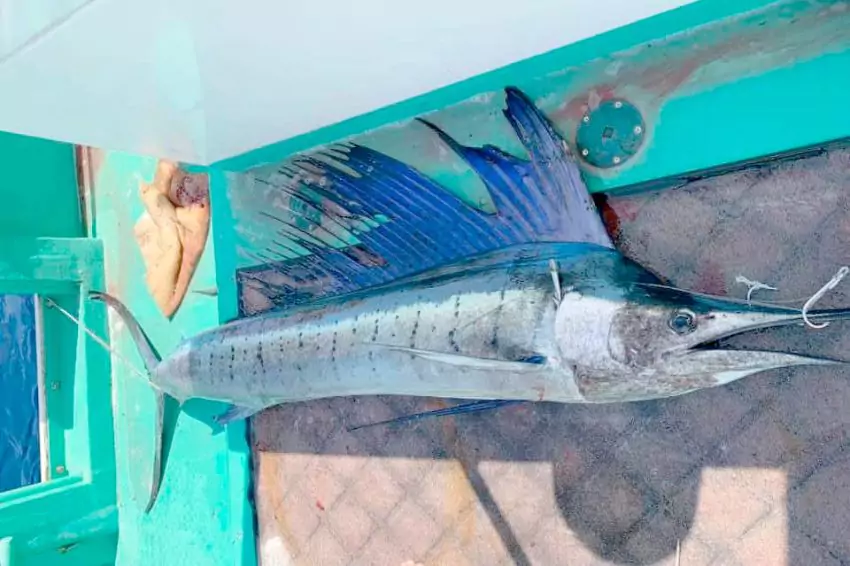Sailfish is a popular game fish known for its speed and powerful fighting abilities. But can you eat Sailfish? The answer is yes: Sailfish is edible and safe to eat. However, it is not the most popular fish to eat, and most people view Sailfish as a game fish you catch for competitive fishing.
Sailfish is a type of billfish, and you will need a special permit to harvest them legally from the water. If you catch a sailfish, you can keep it and eat it, but it is recommended that you release it back into the water to preserve the population. Despite being a game fish, many people still consume Sailfish worldwide.
In a Few Points: The Article
- Sailfish is edible and safe to eat, but other popular fish are available.
- You will need a special permit to harvest Sailfish legally from the water.
- Sailfish is still consumed by many people worldwide. Still, it is recommended that you release it back into the water to preserve the population.
Can You Eat Sailfish?
Yes, you can eat Sailfish. Sailfish is a popular fish in many parts of the world, known for its firm, lean flesh and mild flavor. It is often compared to swordfish or marlin, both billfish. Sailfish is rich in protein, omega-3 fatty acids, and other nutrients.
Is Sailfish safe to eat?
Yes, Sailfish is safe to eat when cooked properly. As with any fish, handling and preparing Sailfish is essential to avoid foodborne illness. Ensure to cook Sailfish to an internal temperature of 145°F (63°C) and follow safe food handling practices when storing and preparing it.
Sailfish Meat
Sailfish meat is firm, white, and flaky with a mild flavor. It is similar to swordfish and marlin, a popular fish for grilling, frying, and baking. Sailfish meat is also used in ceviche, grilled steaks, and sushi dishes.
Sailfish Health Benefits
Sailfish is a healthy fish that is low in calories and protein. It is also a good source of omega-3 fatty acids essential for heart health. Omega-3s can help reduce inflammation, lower blood pressure, and improve brain function.
Sailfish Health Risks
While Sailfish is safe to eat, it does contain mercury, which can be harmful in large amounts. Pregnant women, nursing mothers, and young children should limit their consumption of Sailfish and other high-mercury fish. It is also important to cook Sailfish thoroughly to avoid any potential foodborne illnesses.
When cooking Sailfish, there are many ways to prepare it. Grilling, frying, and smoking are popular methods. Still, it can also be eaten raw as sashimi or marinated in brine and grilled on kebabs. Sailfish can also be used in stir-fry dishes and ceviche.
In Florida, Sailfish is a popular sport fish, and many people enjoy catching and cooking it. Suppose you need help cooking Sailfish or want to try a new recipe. In that case, there are many resources available online that can help you prepare a delicious meal.
- Recommendations:
- Can You Eat Bream Fish
- Can You Eat Alligator Gar?
How do you cook Sailfish?
Sailfish can be cooked in various ways, including grilling, baking, and broiling. It is crucial to cook Sailfish to an internal temperature of 145°F (63°C) to ensure it is safe to eat. Some popular ways to prepare Sailfish include:
- Grilling: Brush Sailfish with olive oil and season with salt and pepper. Grill over medium-high heat for 4-6 minutes per side or until cooked through.
- Baking: Preheat the oven to 400°F (204°C)—Place sailfish in a baking dish and season with salt, pepper, and lemon juice. Bake for 10-12 minutes, or until cooked through.
- Broiling: Preheat the broiler. Brush Sailfish with olive oil and season with salt and pepper. Broil for 4-6 minutes per side or until cooked through.
Sailfish Special Permit

To eat a sailfish, you need to have a special permit. It would help to have an HMS permit to catch and keep a sailfish in the United States. The HMS permit is a federal permit that allows recreational anglers to see and stay with certain fish species, including sailfish, marlin, and swordfish.
You must apply to the National Marine Fisheries Service to obtain an HMS permit. The application process is straightforward, and you can apply online.
You’ll need to provide your personal information, such as your name, address, social security number, and information about your vessel and fishing activity.
Once you have your HMS permit, you must follow specific regulations when catching and keeping sailfish.
These regulations include size limits, bag limits, and reporting requirements. For example, in Florida, the minimum size for sailfish is 63 inches from the tip of the lower jaw to the fork of the tail, and the bag limit is one per person per day.
It’s essential to follow these regulations to ensure the sustainability of the sailfish population. Sailfish are a valuable sportfish and a necessary part of the ocean ecosystem.
By following the rules, we can help ensure that future generations can enjoy catching and eating sailfish.
Sailfish Overfishing
As we continue to enjoy the delicious taste of sailfish, we must also consider the impact of overfishing on their populations. Sailfish are pelagic fish, which means they live in the open ocean and are highly migratory.
They are also a popular sport fish and a delicacy in many parts of the world. Unfortunately, this popularity has led to overfishing in some areas.
Overfishing occurs when fish are caught faster than they can reproduce, leading to a decline in their populations. Sailfish are particularly vulnerable to overfishing because they grow slowly, mature late, and have low reproductive rates.
In addition to overfishing, habitat loss is another threat to sailfish populations. As we continue to develop coastal areas and pollute the ocean, sailfish, and other marine species lose their homes and food sources, which can lead to a decline in their populations and even extinction in some cases.
To address these issues, we must protect sailfish and their habitats, including implementing sustainable fishing practices, such as catch limits and gear restrictions, to ensure that sailfish populations can recover. We must also work to protect their habitats by reducing pollution and preserving coastal areas.





Leave a Reply
You must be logged in to post a comment.